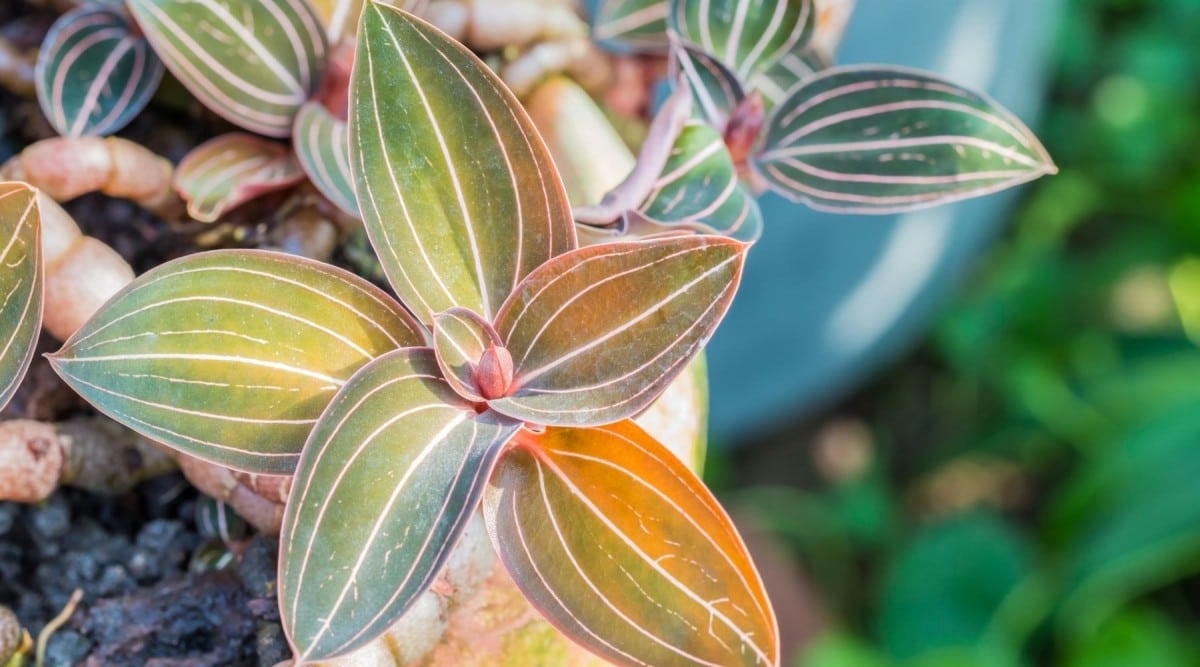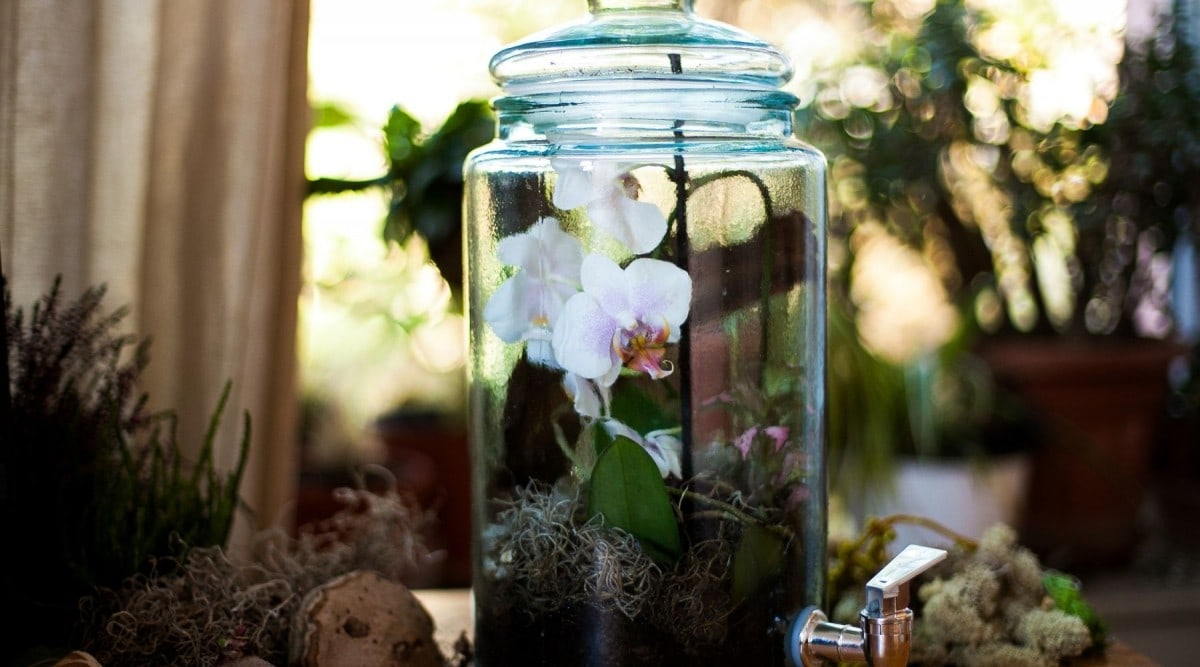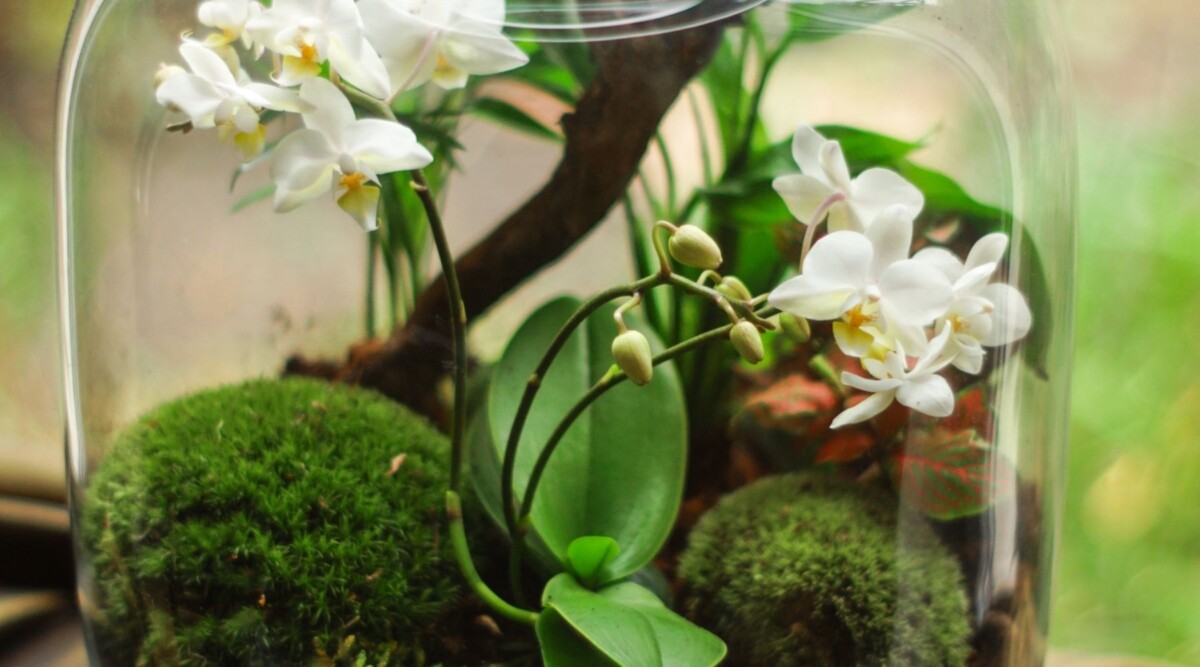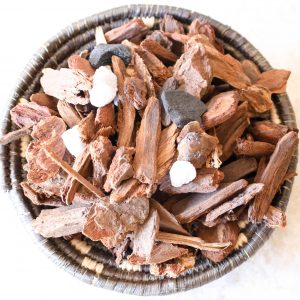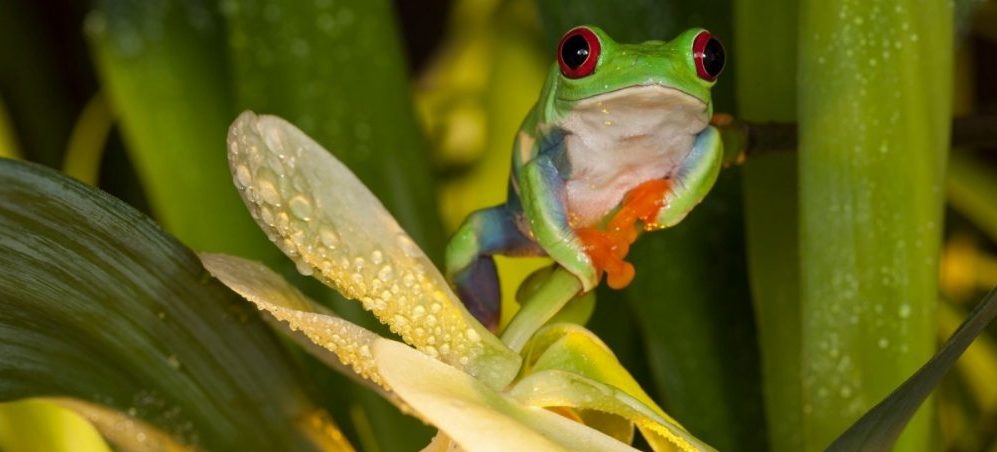
Orchids are one of the best plants to grow in vivariums because they’re easy to maintain, they adapt to the environment, and everything they’re small. Optimal humidity, temperature, and growing room will allow you to plant plenty of orchids in almost any vivarium; but how are you supposed to know which ones to choose?
The best orchids for vivariums are the Platystele, Dracula, Lepanthes, and Masdevallia plants. You could also plant Aerangis Bancoense, Barbosells Australis, Bonnet Orchids, or one of many different genera. Keep the vivarium humid and room temperature to promote a healthy living environment.
Throughout this article, you’ll also learn the following info about choosing the best orchids for vivariums:
- 13 combinations of specific orchids and genera
- Answers to common questions and growing suggestions
- How you can decide which orchids will work with your vivarium
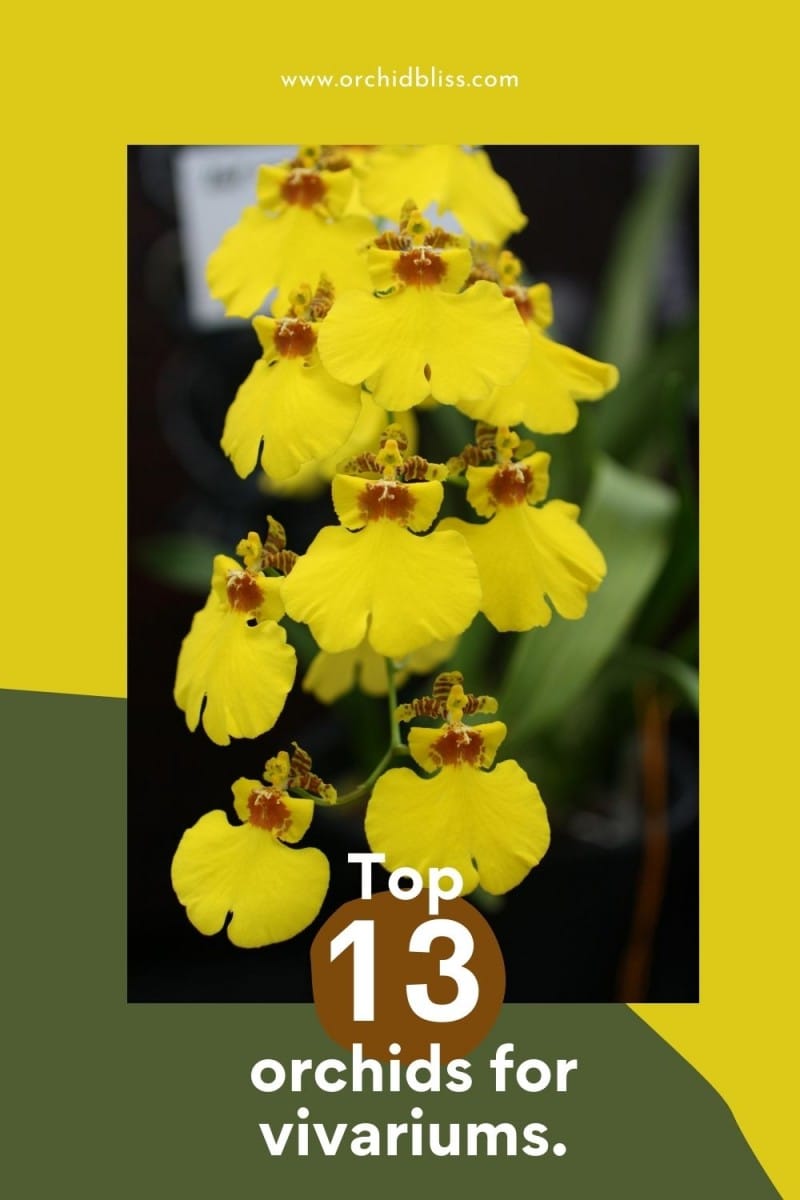
Some of the links on this page may be affiliate links. Click here to learn more.
Platystele
These orchids are some of the smallest around. If you’re trying to grow a handful of plants in a tiny vivarium, then look no further. The platystele is known for its compact leaves and beautiful flowers that don’t get much bigger than a fingernail. They’re small, but there’s no doubt that platysteles bring life to a vivarium.
Taking care of a platystele orchid involved quite a bit of humidity. They grow in mid-to-high elevations and semi-tropical climates, which means there’s a lot of moisture and a mild temperature range. Furthermore, platysteles grow very well with almost any other orchid on the list, making them perfect for vivariums.
The tiny, bright flowers on a platystele are vibrantly violet and red. There are many different types of species, including Sandra Elizabeth, Free Spirit, Trader’s Point, and a few others, all of which are shown and described by the American Orchid Society.
Dracula
Dracula orchids are precisely what they sound like; Creepy, beautiful, unique flowers, unlike anything you’ve ever seen. There are over 90 species of Dracula orchids (also known as its abbreviation, “Drac”). Some of the species look like they have faces with teeth, hence the reference to the character Count Dracula.

Much like the platystele family, Dracula orchids originate from a humid environment in Columbia and Ecuador. They used to be part of the Masdevallia family, a species of orchids that we’ll cover later in the article. Dracula orchids differ due to their origins, narrow tails, and long bases. However, there are numerous similarities between the species.
It’s essential to remember that Dracula orchids can produce up to 6 flowers, which require a lot of care. If the moisture or temperature rapidly changes, it could spell the end of this unique storybook species.
Lepanthes
Originating in South America, the Lepanthes genus is debatably the most mysterious orchid family in the world. There are up to 1,000 types of orchids in the group, many of which don’t have enough details to belong anywhere. One thing’s for sure: Lepanthes orchids are visually stunning with yellow, pink, orange, or white flowers.
Most of the lepanthes family have very small flower petals, making them an ideal fit for vivariums. You don’t have to worry about them overwhelming the tank or taking up too much space from other species. Lepanthes and platystele orchids match well because they’re both small, but they boast bright colors.
Three of the most common lepanthes orchids are nicknamed Cutie, Bryon, and Orquifollajes. Whichever lepanthes you get, you’ll have a fun time watching them bloom and grow unique patterns throughout the year.
Tolumnia
Tolumnia is the perfect inhabitant for large vivariums, but they won’t grow too well in small spaces. AOS suggests hanging them or mounting them to a wooden board, which is a bit tricky in a confined area. However, they only need daily misting and dry roots, so you don’t have to worry about too much maintenance.
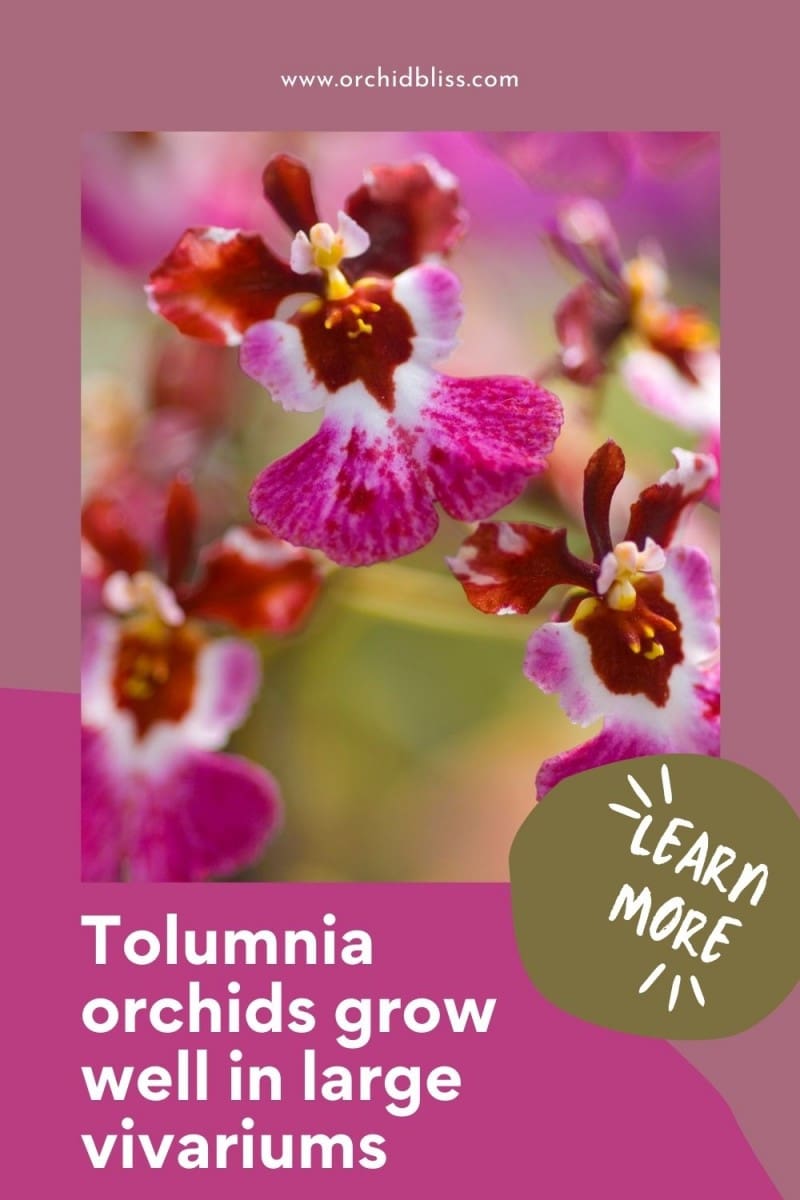
Those with spacious tanks will enjoy the colorful pinks, purples, and oranges that spring out of the flowers of Tolumnia orchids. It’s unlike any other species, especially the small ones that can’t grow large petals. As long as the soil is fast-draining, you shouldn’t have any problems with these plants.
It should be noted that tolumnia orchids attract grubs, flies, and worms to the soil. You’ll need to keep a close watch to prevent root rot and other natural issues that might arise.
If your curious about caring for a tolumnia orchid. You’re in the right place. Click here for a free tolumnia orchid care card.
Masdevallia
The slightly more popular Masdevallia orchid contains over 300 species, all of which include visually stunning flower petals and long stems. They don’t grow well in high temperatures over 75°F (23.9°C), so make sure that you can control the internal thermometer if you’re considering this family.
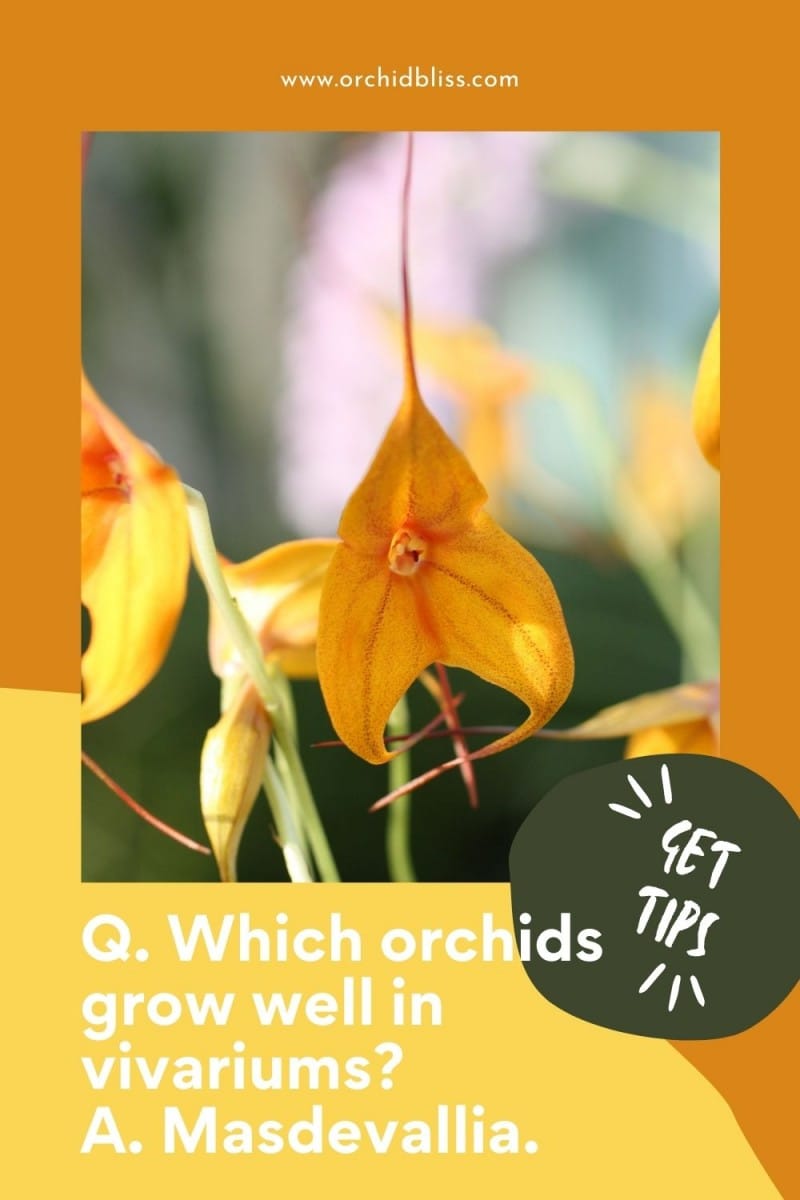
Masdevallia orchids have semi-short roots, which means they run out of water quickly. The roots should stay dry with moist soil, but too much water can lead to root rot, flooding, and fungal growth. A daily misting should be more than enough to keep them hydrated without causing long-lasting damage.
You can keep your orchids near a window or use artificial light fixtures to provide UV rays. However, too much light can be detrimental to Masdevallias. Try testing a few locations to figure out which spots don’t cause yellowing or wilting on the stems, leaves, and flowers.
Aerangis Calantha
Aerangis Calantha orchids typically have long leaves and stems with flowers that droop well below the plant’s top. The flowers look like a white burst of sunshine, providing much-needed color to any vivarium. Since they grow up to (and sometimes over) five inches tall, you’ll need a mid-to-large vivarium.
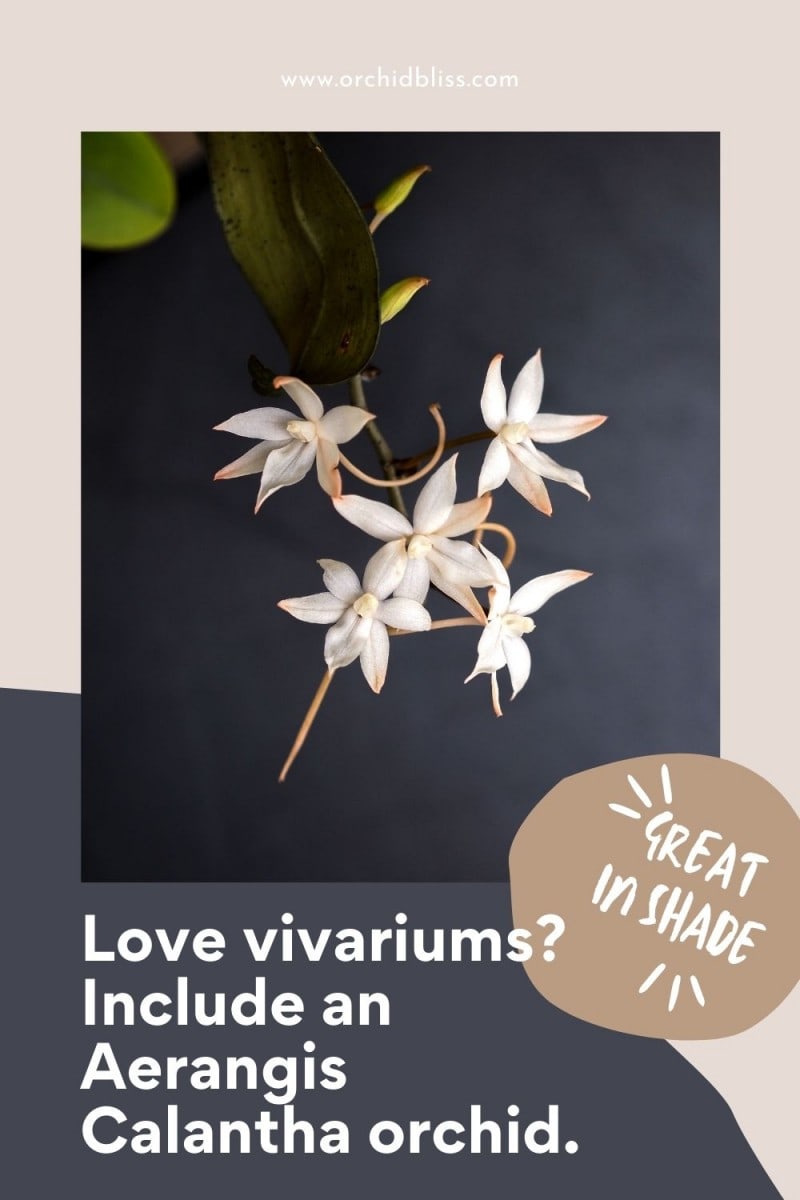
They pair well with Spanish moss and river rocks, but you’ll have a hard time matching Aerangis Calantha with other orchids. These flowers tend to hog the soil and space, meaning your other plants will end up hungry and thirsty. However, if there’s enough room, you can grow platysteles, lepanthes, and other small orchids.
The bright white flowers are matched with deep, dark green leaves. They’re much darker than most orchids, and they prefer shaded regions to warm, sunny parts of the house. Your Aerangis Calantha orchids will wrap around large rocks, too.
Angraecum Bancoense
Unlike most other orchids on the list, Angraecum Bancoense isn’t found in South America. It originates from the other side of the world in Africa, from north to south. This orchid species can handle slightly warmer temperatures than South American orchids, but they still need quite a bit of humidity to stay hydrated.
To absorb and hold more moisture, Angraecum Bancoense has thick leaves, much like succulents. They’re layered on top of one another to provide protection and to stretch toward the sunlight. That being said, they prefer plenty of shade to prevent scorching, dryness, yellowing, and wilting.
These orchids are covered in flowers between each leaf from top to bottom. They add beautiful decoration to almost any vivarium, though they can be quite big. Mid-to-large vivariums are recommended for Angraecum Bancoense.
Barbosella Australis
The Barbosella Australis orchid originates from Brazil. It needs plenty of shade with periodic sunlight throughout the day. These orchids are tall, droopy, and require enough space to hang. They’re perfect for mounting on a wooden board, but you can make room for them in extra-large vivariums.
Barbosella Australis orchids are thin and covered in leaves and flowers. However, they take up a lot of space since they’re bushy and spread out. One or two of these plants are more than enough to fill most vivariums. As explained by WSBE Orchids, the word ‘Australis’ means ‘south’ and has nothing to do with Australia.
Much like most orchids, Barbosella Australis requires daily mists to stay hydrated but not overwatered.
Bonnet Orchids
If you’re looking for an Australian orchid, then you should check out Cryptostylis erecta, nicknamed the Bonnet orchid. It has a tall, thin stem with numerous leaves that branch off in various directions. These plants have a hood or tongue at the top that looks like a bonnet, hence the silly nickname. Make no mistake, bonnet orchids are tough!
Since they’re from Australia, bonnet orchids aren’t easily damaged by heat. However, they thrive in semi-shaded vivariums with daily misting sessions. Keep the soil moist without flooding it. Also, make sure the roots stay dry so they’re not exposed to fungal growth or root rot.
Compared to other orchids, bonnet orchids can be quite tall. You’ll need a big vivarium, but you can grow many small orchids around its base since it’s not too wide. These orchids are a great choice if you intend to transplant them to an outside garden.
Cockleshell Orchids
Cockleshell orchids, also known as clamshell orchids, or more scientifically, the Encyclia cochleata as Gardening Know How explains, are very popular because they’re rare, blooming through the year, and very fragrant. Many orchids are scentless or smell like most other plants, but cockleshell orchids add freshness to the air like never before. From the unique markings to the dropping tentacle leaves, it’s no wonder so many people prefer them.
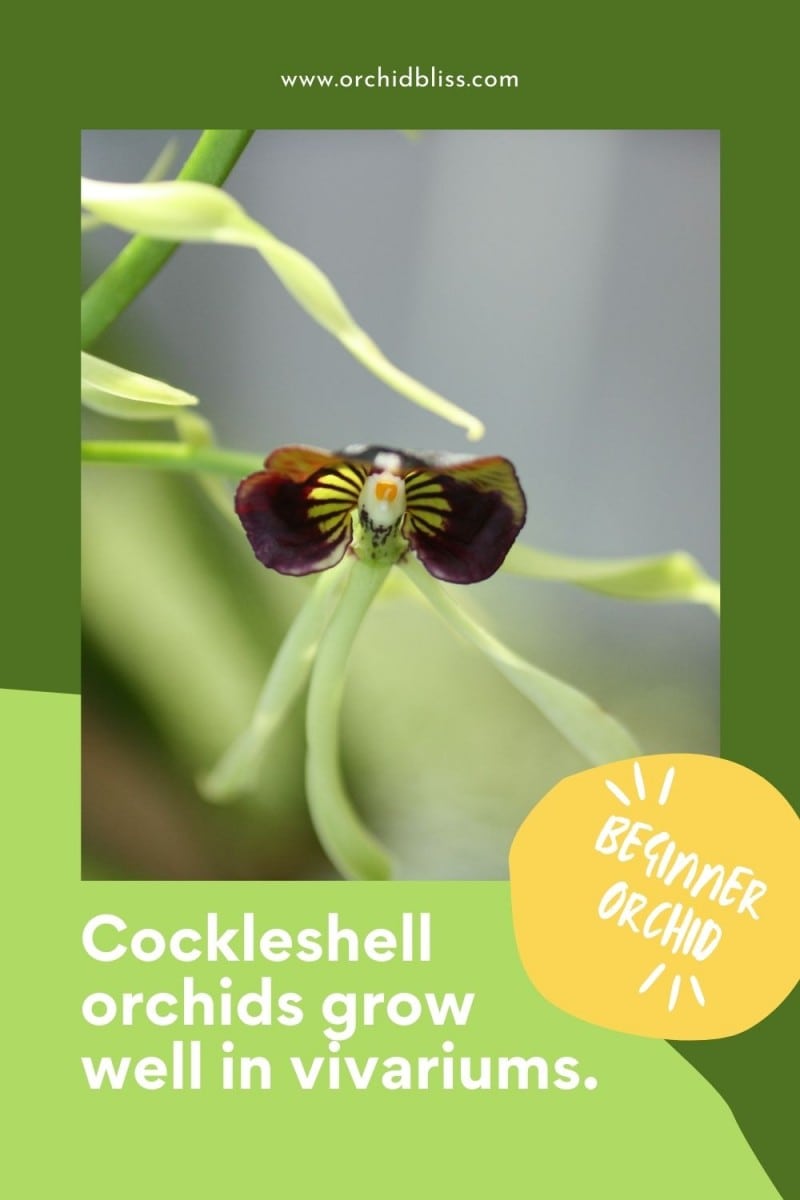
Since they were widely picked throughout Florida, cockleshell orchids aren’t as common as they used to be. However, you can find a dealer that will send seeds or potted clamshell orchids to add to your collection. They’re known to be one of the easiest orchids for beginners, but they come at a steep price.
These orchids, much like other genera, require lots of shade, filtered sunshine, and plenty of water. Let the roots stay semi-dry by misting them once every other day. In their natural habitat, these orchids absorb water from the air and rain, so they don’t need a gardening pot or hose to stay hydrated.
Angraecum Pyriforme
This orchid species are dying off, unfortunately. Due to global warming and poachers, it might not be around for much longer. Angraecum Pyriforme is a resilient group of orchids that’s made it through quite a few natural battles due to its long, thin stems and leaves that pull moisture from various sources.
It comes from Africa, but many people worldwide enjoy these beautiful plants. They need regular misting to accommodate the roots and nutrient-dense soil. The vivarium needs to be at the high end of the humidity scale, reaching between 75% to 80% for Angraecum Pyriforme to survive and thrive.
Pumpkin Beth describes these orchids’ smell as ‘meadow-like,’ providing freshness throughout your home, not just the vivarium. The waxy leaves are similar to many succulents, though they don’t hold water as long.
Bulbophyllum
According to the American Orchid Society, Bulbophyllum orchids are one of the biggest orchid groups in the world. They’re composed of species from Southeast Asia, Australia, Africa, and all over the world. Most of them are long, spindly, and full of color. They’re great for those who desire vivariums packed with unique orchids that share space well.
While most Bulbophyllums are thin, there are a few that grow thick, bulky leaves. These variants come from Africa since the heat can be overwhelming for skinny plants that can’t hold enough moisture. Regardless of the thickness, all Bulbophyllum orchids need daily misting to hydrate the soil.
Epidendrum Genus
Last but not least is the Epidendrum orchid genus. This group is loaded with stunning colors, unlike any other orchid family in the world. The pinks, yellows, and oranges look like they were computer-generated. These too-good-to-be-true orchids have long, thin, delicate petals that require lots of care.
There are over 1,500 species of Epidendrum orchids. They were first grouped in the mid-1700s, making them one of the oldest, largest orchid families worldwide. Despite the fragile petals, their roots and leaves can wrap around rocks, soil, and everything in between. Fill the vivarium will jagged stones and watch as your new orchids find their way through the divots and bumps.
How To Choose the Best Orchids for Vivariums
You’ve seen all of the best orchids for your vivarium, but that doesn’t narrow the question entirely. How should you know which ones will work for your environment? Fortunately, you’re in the right place to learn everything about picking out the perfect orchids for vivariums.
Here’s a 5-step process to choose your new vivarium orchids:
- Decide how many orchids you’ll plant and how much space you’ll have to work with. Some orchids need more room than others. Roots, leaves, and stems can get in the way of nearby plants, including other orchids. You’ll need a big vivarium to fit more than a few orchids to prevent nutrient deprivation and lack of hydration.
- Consider every orchid’s requirements. Most orchids have similar necessities, including hydration, soil, ventilation, and enough shade to prevent excess sunlight exposure. However, it would be best if you based your decision off where they originate. Rainforest orchids need more humidity than African orchids, for example.
- Base your decisions on color, texture, and size. Now that we have the basics out of the way, it’s time for the fun part. You should love the way your orchids look and feel, so why not choose the depth of greenery, leaf thickness, and overall size? Some orchids mimic vines, while others are short and stubby.
- Beginners should start with the easiest, least-needy orchids. Losing a plant can be sad and discouraging. Instead of starting your vivarium journey on the wrong foot, you should consider getting easy orchids. Don’t get anything that requires too much humidity, perfect temperature settings, or loads of growing room.
- What other plants are in the vivarium? Spanish moss and other air plants is an excellent plant to grow alongside orchids. It’s beautiful, it changes the vivarium’s color spectrum, and it doesn’t get in the way of the growing orchids. Marble Queen Pothos is a big plant, but it’s excellent for large vivariums with orchids.
As you can see, orchids aren’t the most challenging plants to grow. If you keep these five suggestions in your mind when you’re choosing yours, you’ll have no problem finding success; That is, of course, if you don’t make one of the common mistakes in the following section.
What To Know Before You Start
Great! You have your orchids, a few other plants, and they all look beautiful. Before you start planting them in the soil, you should look at a handful of tips to keep everything nice and smooth. Below, you’ll find some expert suggestions to prevent your orchids from rotting or withering away.
- Add plenty of rocks and twigs for the orchids to grow on. Orchids naturally grow with loads of rocks and other plants nearby, so it’s no surprise that they need the same environment wherever they go. Your vivarium should have river rocks, small twigs, and vitamin-rich soil to promote healthy growth.
- If your vivarium is too small, you won’t be able to plant many orchids. Vivariums are small as it is, so there’s no need to overload them with too many orchids, rocks, and so on. While there’s no one-size-fits-all answer, you should find out how big your orchids will grow before choosing a vivarium.
- Spanish moss grows well with orchids and other vivarium plants. As mentioned earlier in the article, it’s a beautiful plant that grows around the orchids rather than stealing nutrients or occupying too much of the soil. In other words, Spanish moss and orchids grow hand-in-hand.
- Clean everything before planting your new orchids. Bacteria, fungi, and other contaminants can ruin the soil and orchids quickly. Don’t forget to wash everything with soap and hot water before planting your orchids or filling the vivarium with soil. Let it dry out to remove excess moisture, too.
- A humidistat is a must-have tool for your vivarium. Humidistats track both temperature and humidity, allowing you to keep an eye on the temperature to prevent rapid changes, and the ambient humidity. Orchids need between 60% to 80% humidity throughout the day.
These tricks will set your orchids up for success. You don’t have to worry about mold, mildew, fungi, or deprivation if you follow the suggestions mentioned above. If you’re a beginner and you’re concerned for the vivarium’s inhabitants, then the next section will be a breath of fresh air.
Common Mistakes of Growing Vivarium Orchids
If you’re naturally a green thumb, then you might not need to read this section. It covers the basics to keep beginners from losing their orchids or ruining the vivarium. Choosing the wrong soil, adding too much water, or getting a massive vivarium for one orchid are reasonable mistakes, but you’ll find a few other common problems below.
Don’t Plant Your Orchids by Themselves
It’s perfectly acceptable to put one orchid in the middle of the vivarium with nothing else in sight (other than soil), but it’s going to look very strange. Add some river rocks, twigs, and Spanish moss to spice things up. These small additions can make a world of difference in the vivarium’s appearance.
Beginners often over-concern themselves with the amount of space required to grow their orchids properly. They need a bit of room, but keep in mind that they’re used to growing in forests loaded with other plants. Orchids aren’t strangers to crowded environments. As long as their roots can thrive, they’re good to go.
Adjust the Temperature When Needed
Keep a thermometer against the inside of the vivarium’s glass so you can check the internal temperature whenever you need to. If it drops too low, the orchids could freeze. On the other hand, excess heat can cause dehydration and wilt the orchid’s leaves and stems.
Note: Orchids prefer shaded environments, so don’t try to adjust the temperature with extended hours of sunshine. A few 30-minute sessions won’t hurt, but they shouldn’t be exposed to the sunlight all day.
Humidity Is Crucial
Use a humidistat to monitor the humidity. If the vivarium is completely sealed, it’ll naturally produce a bit of humidity. However, you might need to mist the tank every so often to reach the aforementioned 60% to 80% humidity requirement of most orchid varieties.
These three mistakes might seem simple, but you’d be surprised about the impact that they can make. Each issue causes a ripple effect that causes dryness, nutrient deprivation, wilting, bacterial growth, and many other forms of plant problems.
FAQ
You might have some additional questions about orchids, vivariums, and how they work together. The good news is that you’ll find five answers to the most commonly asked questions about this wonderfully easy household setup. You can grow orchids in vivariums in almost any environment. Check out these questions and start the process with confidence.
How Long Do Orchids Survive in Vivariums?
Orchids can live longer than most humans! It’s not uncommon for them to last up to 100 years or more with proper care and maintenance. Keep the soil full of life, hydrate the air, and keep the temperature in check for your life-long companions.
How Many Orchids Can You Fit in the Container?
It’s hard to answer this question because most orchids have different requirements. If they have small stems and leaves, then you could probably fit 3 to 5 orchids, sometimes more, in a vivarium. Again, it depends on the soil depth, orchid size, and vivarium square footage.
What Other Plants Grow Well With Orchids?
Spanish moss, Marble Queen Pothos, ferns, and many other large plants are perfect for orchids, but it depends on how big your vivarium is. As you could probably assume by now, Spanish moss is always a safe bet for almost any vivarium size. You could also decorate the container with multiple orchid species.
How Deeply Do Orchid Roots Grow?
Orchid roots only grow between two to three inches, sometimes more, sometimes less. However, if they grow too rapidly, they’ll push themselves out of the soil and be left exposed. If this happens, remove the orchid, add more soil, mix it together, and replant the orchid.
What’s the Easiest Orchid for Beginners?
Moth Orchids tend to be the easiest orchids to grow because they adapt to the environment and thrive. Since they don’t break down quickly from temperature or humidity changes, there’s a bit of room for error.
Hopefully, all of your questions were answered in this section. The quickest way to grow orchids in a vivarium is to get started as soon as possible. This post has everything you need to begin the journey. Gather the following supplies for the best results:
- Orchids
- Mid-sized vivarium
- Hygrometer
- Thermometer
- Nutrient-rich soil
- Mister (if needed)
- Spanish moss
- River rocks
Conclusion
Now that you know which orchids will thrive in a vivarium and how you can keep them healthy, it’s time to gather the supplies. Orchids are tough plants, but they have a set of necessities required for growing and living.
Here’s a quick recap of the post:
- There are countless orchids that you could grow in a vivarium.
- A lack of humidity and hydration can ruin everything before it starts.
- The shape, size, and features in the vivarium affect your orchids.
- Monitor the plants for the first few days after planting them.
Discover more about keeping your orchid’s leaves and roots healthy by grabbing your free, cheat sheet. Click here to grab your cheat sheet to learn how to grow healthier orchids. It will be super helpful.
Related articles:
Sources
- Orchideria: 5 Best Orchids for Closed Terrariums
- Pumpkin Beth: Mini Miniature Orchids for Terrariums, Vivariums, and Bottle Gardens
- Orchid Board: Beginner Vivarium with Micro Mini Orchids
- DendroBoard: Beautiful Orchids for Vivarium?
- Just Add Ice: Help Your Plant Thrive With This DIY Orchid Terrarium
- Bella Online: Hygrometers, Thermometers, and Light Meters

